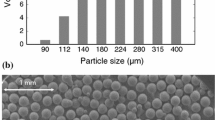Abstract
It is shown analytically that one of the reasons for the improvement of the tribotechnical properties of polymer composites obtained using the technology of dissolution of filler particles in the polymer melt is the reduction of the matrix loading due to the existing possibility of aggregation of a significant part of the dispersed particles into aggregates that are oriented perpendicularly to the contact surface. The dependences are obtained that reflect the connection between the magnitude of the relative intensity of composite linear wear and the value of the volume concentration for nano- and microparticles of the filler. The cases of filling with particles of materials with higher and lower shear resistances relative to the matrix one are considered.
Similar content being viewed by others
References
Mashkov, Yu.K., Ovchar, Z.N., Baibaratskaya, M.Yu., et al., Polimernye kompozitsionnye materially v tribotekhnike (Polymer Composite Materials in Trobotechnics), Moscow: Nedra, 2004.
Berlin, A.A., Vol’fson, S.A., Oshmyan, V.G., et al., Printsipy sozdaniya kompozitsionnykh polimernykh materialov (The Principles of Creation of Composite Polymer Materials), Moscow: Khimiya, 1990.
Friction and Wear of Polymer Composites, Friedrich, K., Ed., Amsterdam: Elsevier, 1986.
Belyi, V.A., Sviridenok, A.I., Petrokovets, M.I., Trenie polimerov (Polymer Friction), Moscow: Nauka, 1972.
Drozdov, Yu.N., Nadein, V.A., Savinova, T.M., Generalized Characteristics to Determine the Wear Life of Technical Ceramics, Trenie Iznos, 2008, vol. 29, no. 1, pp.28–36.
Dobychin, N.M., Morozov, A.V., Nikulin, A.V., et al., Planning the Experiment upon Investigation of the Tribotechnical Characteristics of Phenol Carbonplastics, Vopr. Materialoved., 2009, no. 1, pp. 186–193.
Shwartz, C.J., Bahadur, S., Studies on the Tribological Behavior and Transfer Film-Counterface Bond Strength for Polyphenylene Sulfide Filled with Nanoscale Alumina, Wear, 2000, vol. 237, pp. 261–273.
Okhlopkova, A.A., Vinogradov, A.V., Pinchuk, A.S., Plastiki, napolnennye ul’tradispersnymi neorganicheskimi soedineniyami (Plastics Filled with Ultra-dispersed Inorganic Substances), Gomel’: Id. IMMS NANB, 1999.
Sawyer, W.G., Freudenberg, K.D., Bhimataj, P., et al., A Study on the Friction and Wear Behavior of PTPE Filled with Alumina Nanoparticles, Wear, 2003, vol. 254, pp. 573–580.
Author information
Authors and Affiliations
Additional information
Original Russian Text © Yu.P. Kozyrev, E.B. Sedakova, 2010, published in Problemy Mashinostroeniya i Nadezhnosti Mashin, 2010, No. 4, pp. 86–91.
About this article
Cite this article
Kozyrev, Y.P., Sedakova, E.B. The effect of the process of directed aggregation of particles on the characteristics of polymer antifriction nanocomposites. J. Mach. Manuf. Reliab. 39, 375–379 (2010). https://doi.org/10.3103/S1052618810040126
Received:
Published:
Issue Date:
DOI: https://doi.org/10.3103/S1052618810040126




